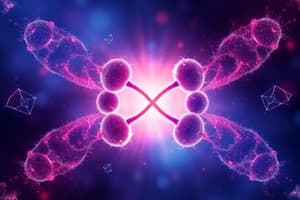Podcast
Questions and Answers
What is the main purpose of cell division?
What is the main purpose of cell division?
- To ensure proper chromosome alignment
- To repair damaged DNA
- To produce genetically identical nuclei
- To allow cells to grow, divide, and reproduce (correct)
Which type of cell division results in the formation of sex cells?
Which type of cell division results in the formation of sex cells?
- Binary fission
- Mitosis
- Meiosis (correct)
- Chromosomal rearrangement
What is the main difference between mitosis and meiosis?
What is the main difference between mitosis and meiosis?
- Mitosis produces genetically identical cells, while meiosis results in genetically diverse cells. (correct)
- Mitosis only occurs in plants, while meiosis only occurs in animals.
- Mitosis has one round of cell division, while meiosis has two rounds.
- Mitosis involves the formation of sex cells, while meiosis does not.
What is the role of chromosomes in cell division?
What is the role of chromosomes in cell division?
How many genetically identical nuclei are produced during mitosis?
How many genetically identical nuclei are produced during mitosis?
Which phase of the cell cycle involves the actual nuclear division and cytoplasmic separation?
Which phase of the cell cycle involves the actual nuclear division and cytoplasmic separation?
How many chromosomes do humans have in total?
How many chromosomes do humans have in total?
During which subphase of interphase does DNA replication occur?
During which subphase of interphase does DNA replication occur?
Which stage of meiosis involves the division of homologous chromosomes?
Which stage of meiosis involves the division of homologous chromosomes?
What is the first phase of the cell cycle?
What is the first phase of the cell cycle?
Flashcards are hidden until you start studying
Study Notes
Biology: Understanding Cell Division, Chromosomes, the Cell Cycle, Mitosis Stages, and Meiosis Stages
Cell division is an essential part of biology, involving processes that allow cells to grow, divide, and reproduce. During these events, chromosomes play a critical role in ensuring genetic information is correctly passed down from parent cells to daughter cells. Two main types of cell division occur in organisms: mitosis and meiosis. Each type serves distinct purposes and has various stages. Understanding these concepts is fundamental to grasping the principles of life's building blocks.
Cell Division
Cell division is the process by which a single cell divides into two identical daughter cells. It ensures growth during development, tissue repair, and reproduction. Cell division consists of two main types: mitosis and meiosis.
Mitosis
Mitosis is a binary fission process where a cell splits once, producing two genetically identical nuclei. These nuclei then split again, forming two complete cells. Mitosis is primarily responsible for growth and tissue repair.
Meiosis
Meiosis is the process that leads to the formation of sex cells (gametes) which combine during fertilization. Meiosis has two rounds of cell division, resulting in four individual gamete cells that carry half the number of chromosomes compared to the original cell.
Chromosomes
Chromosomes are threadlike structures composed of proteins and deoxyribonucleic acid (DNA) that contain genetic information. Humans have 46 chromosomes, organized into 23 pairs. Chromosomes are visible only when stained and viewed through a microscope.
Cell Cycle
The cell cycle refers to the continuous activities of growth and division occurring in a cell until it reaches maturity or dies. The cell cycle comprises three phases: interphase and mitosis or meiosis.
Interphase
Interphase is the first phase of the cell cycle, lasting approximately 90% of the total duration. During interphase, the cell grows, synthesizes RNAs and proteins, replicates its DNA, and prepares itself for the subsequent changes during mitosis or meiosis. Interphase can be further divided into three subphases: G1 (growth), S (synthesis), and G2 (growth).
Mitosis/Meiosis
These phases involve actual nuclear division and cytoplasmic separation. Mitosis and meiosis share similarities but have different outcomes. Both consist of prophase, metaphase, anaphase, telophase, and cytokinesis. However, meiosis has additional stages called meiosis I (division of homologous chromosomes) and meiosis II (division of sister chromatids).
Studying That Suits You
Use AI to generate personalized quizzes and flashcards to suit your learning preferences.




